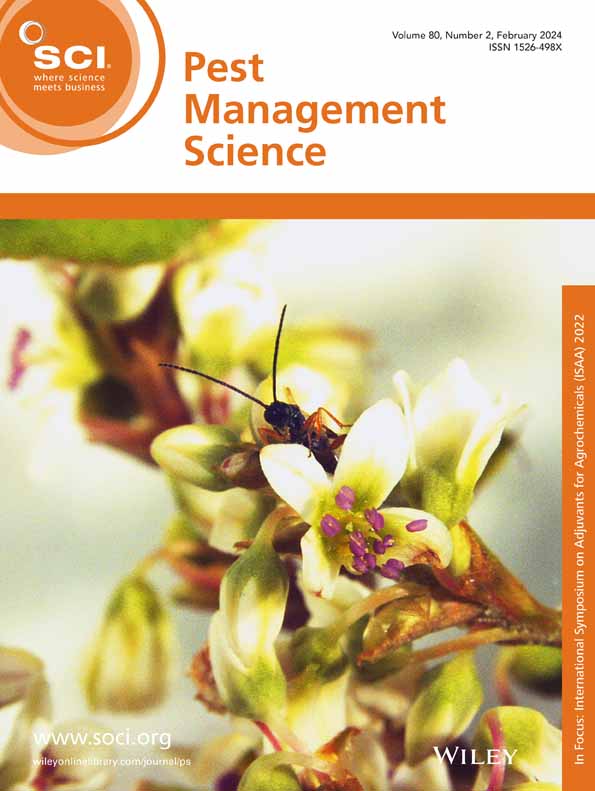Enhanced accumulation of indole glucosinolate and resistance to insect and pathogen in flowering Chinese cabbage by overexpression of Arabidopsis CYP79B2 and CYP83B1.
IF 3.8
1区 农林科学
Q1 AGRONOMY
引用次数: 0
Abstract
BACKGROUND Indole glucosinolates (IGs) are a group of phytochemicals that are derived from tryptophan and mainly found in Brassicaceae. The breakdown products play an important role in insect and disease resistance. To metabolically engineer the IG pathway flux in flowering Chinese cabbage (Brassica rapa L. ssp. chinensis var. utilis Tsen et Lee), binary constructs comprising two Arabidopsis cytochrome P450 complementary DNAs (cDNAs), AtCYP79B2 and AtCYP83B1, under the control of a cauliflower mosaic virus 35S promoter were tandemly introduced into flowering Chinese cabbage via Agrobacterium-mediated genetic transformation. RESULTS The results showed that overexpression of AtCYP79B2 and AtCYP83B1 was accompanied by higher accumulation levels of IG in the transformed plants compared to the wild-type control. Glucobrassicin was the main component of IG that accumulated at approximately 2 μmol/g dry weight (DW) indole-3-acetic acid. 4-Hydroxy glucobrassicin and glucobrassicin were the most affected components in transgenic plants, exhibiting an approximately 5- and 4-fold, respectively, when compared to wild-type control. In both trials of the Sclerotinia sclerotiorum infection and Spodoptera exigua feeding, the transformants significantly inhibited the growth of S. sclerotiorum and S. exigua. Transcriptomic analysis indicated that overexpression of AtCYP79B2/83B1 cDNAs led to the up-regulation of 152 genes and down-regulation of 88 genes. Kyoto Encyclopedia of Genes and Genomes (KEGG) pathway enrichment analysis suggested that the genes involved in plant-pathogen interaction, plant hormone signal transduction, and MAPK signaling pathways are primarily responsible for enhanced resistance to S. sclerotiorum and S. exigua. CONCLUSION Our study illustrates a successful use of the genes encoding IG pathway enzymes to increase IG content and resistance to insect and fungal pathogens via regulated expression of a broad spectrum of the genes associated with the innate immune responses in flowering Chinese cabbage. © 2025 Society of Chemical Industry.过表达拟南芥CYP79B2和CYP83B1增强开花白菜吲哚硫代葡萄糖苷积累和抗虫、抗病能力。
dindole glucosinolates (IGs)是一类从色氨酸中提取的植物化学物质,主要存在于十字花科植物中。分解产物在抗虫抗病中起着重要作用。目的:对开花白菜(Brassica rapa L. ssp) IG通路进行代谢工程。在花菜花叶病毒35S启动子的控制下,通过农杆菌介导的遗传转化,将含有2个拟南芥细胞色素P450互补dna (AtCYP79B2和AtCYP83B1)的二联体构建体引入开花白菜中。结果结果表明,与野生型对照相比,转化植株中AtCYP79B2和AtCYP83B1的过表达伴随着更高的IG积累水平。吲哚-3-乙酸含量约为2 μmol/g干重(DW)。与野生型对照相比,转基因植株中受影响最大的成分是羟基葡萄糖苷和葡萄糖苷,分别约为5倍和4倍。在侵染菌核菌和取食黑斑夜蛾的两项试验中,转化菌均能显著抑制黑斑夜蛾和黑斑夜蛾的生长。转录组学分析显示,AtCYP79B2/83B1 cdna过表达导致152个基因上调,88个基因下调。京都基因与基因组百科(KEGG)途径富集分析表明,参与植物-病原体相互作用、植物激素信号转导和MAPK信号通路的基因是增强对菌核葡萄球菌和枯萎葡萄球菌抗性的主要原因。结论本研究成功地利用IG通路酶的编码基因,通过调控白菜固有免疫应答相关基因的广谱表达,提高了IG含量,提高了白菜对昆虫和真菌病原体的抗性。©2025化学工业协会。
本文章由计算机程序翻译,如有差异,请以英文原文为准。
求助全文
约1分钟内获得全文
求助全文
来源期刊

Pest Management Science
农林科学-昆虫学
CiteScore
7.90
自引率
9.80%
发文量
553
审稿时长
4.8 months
期刊介绍:
Pest Management Science is the international journal of research and development in crop protection and pest control. Since its launch in 1970, the journal has become the premier forum for papers on the discovery, application, and impact on the environment of products and strategies designed for pest management.
Published for SCI by John Wiley & Sons Ltd.
 求助内容:
求助内容: 应助结果提醒方式:
应助结果提醒方式:


